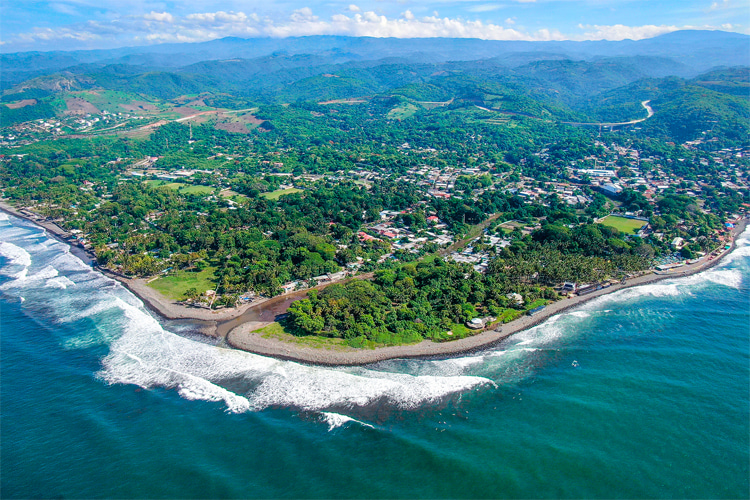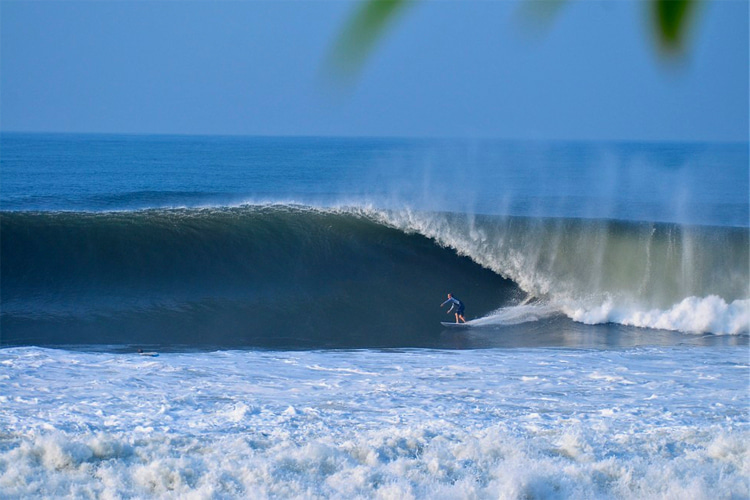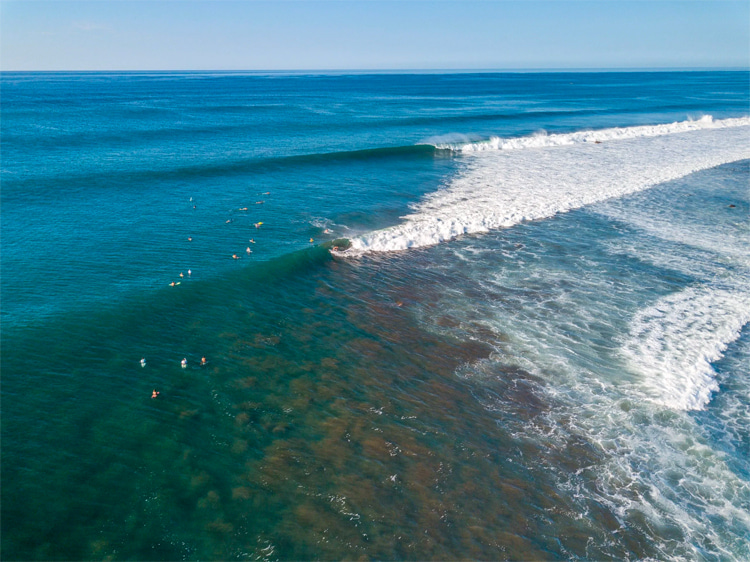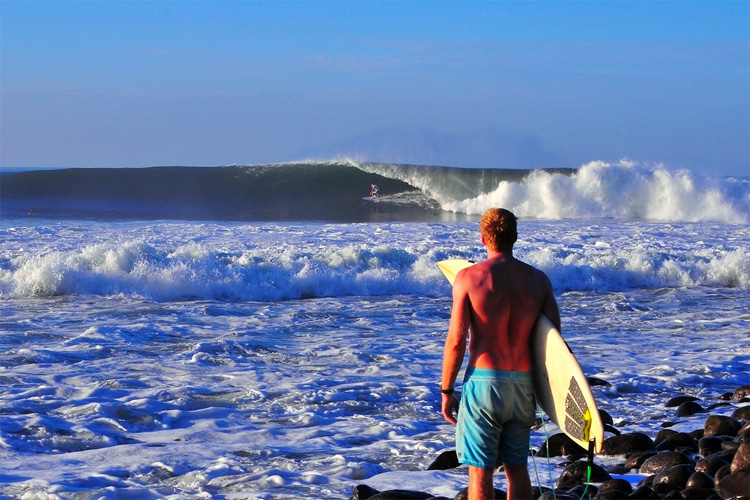Punta Roca is one of the world's finest high-performance right-hand point breaks and a dream surfing destination for regular footers.
With only 1.5 million people in El Salvador, crowds are kept to a minimum, except around larger metropolitan centers.
The area west of Puerto de La Libertad is an excellent place to search for totally empty waves.
Punta Roca, the legendary El Salvador wave, is located near this small town, which is also the country's first commercial harbor.
The original pier port was founded in 1869 but was only visited and explored by nomad surfers in the 1950s.
The city of La Libertad, also known as El Puerto, has since begun exploring its touristic potential, even though the 1980s civil war partially halted its growth.
Punta Roca is located three miles (five kilometers) east of La Libertad, on the southwest coast of this wave-rich nation.
El Salvador's most famous surf break is directly exposed to the Pacific Ocean south by west (SbW), meaning it gets swells from a 180-degree window.
Hawaiian surfing guru and Pipeline Master Gerry Lopez was one of the first acclaimed surfers to ride Punta Roca.
In the 1970s, he and other foreign surf adventurers encouraged locals to give surfing a go and explore and develop their unique natural resources.
Two decades later, tourists returned to Latin America's best right-hand point break wave, and La Libertad flourished as a thriving surf town.
"La Libertad itself has a reputation for being a rather sketchy town where thieves sometimes prey on unwary surfers and tourists," notes Chris Power, author of "Surf Travel: The Complete Guide."
"However, the local police are apparently making efforts to step up patrols and stamp out robberies. Keep your wits about you and maintain a low profile."
Professional surfer Bryan Perez is one of Punta Roca's local heroes.

A Window Into the Pacific
The El Salvador coastline mainly faces south, so it only receives W-SSE swells from the South Pacific.
The exposure to these swells is excellent, making El Salvador a very consistent destination with plenty of small, clean lines wrapping perfectly around the headlands.
Mid-to-long-period swells produce 8-10-foot (2.6-3.2 meters) rideable waves at most spots.
The main swell season is March-November, but it can be considered a year-round destination as any small swell will produce quality waves.
The region is also blessed by WNW-to-N offshore winds during the off-season.
In the rainy season, winds will often blow offshore in the morning, switch to side-shore around 10 am, and eventually redirect to onshore when the thunderstorms break out.
The tidal range doesn't exceed six feet (two meters) but still affects the rocky points.

The Uniqueness of Punta Roca
But what makes Punta Roca a world-class wave?
Punta Roca is a cobblestone freight train wave that peels perfectly from 100 to 200 yards (90-180 meters) and breaks onto shallow, black boulders.
Under the ideal wind and swell conditions, a set wave can produce a 300-yard (275-meter) ride that will break almost parallel to the rocks and pebble shoreline.
Punta Roca is also known locally as Punta Chilama or La Punta and offers a wide variety of rideable sections.
It is often compared to South Africa's Jeffreys Bay.
The best conditions occur when an offshore NE-N wind combines with an S/SW swell.
The average water temperature in June is 86 °F (30 °C).
With prime conditions, the perfectly aligned swells produce magnificent waves, allowing multiple airs, turns, and barrels on the same ride.
The main take-off zone at Punta Roca is located right off the nearby point.
After negotiating the take-off, surfers need to watch for Mama Roca, a nearby rock that can be dangerous, especially when the tide drops.
Powerful, hollow, and fast, La Punta is no place for beginners.
"When it's on, a fierce local contingent vies with a pack of wave-hungry gringos for the best barrels," adds Power.
"For those who can't handle the steep take-offs or the tricky paddle-out at the point, the inside section known as La Paz offers a slower, mellower ride."
Punta Roca needs to be at least three feet (one meter) to break off the rocks, but it holds surf of up to 12 feet (four meters).

Alternative Nearby Surf Spots
Closer to town is La Paz, a less critical, fun point that's rocky but nevertheless popular with the locals.
Another peak in town offers good lefts at The Pier, but it's usually full of kids who don't mind the proximity of the sewage pipe.
Beginners may want to try the small swell beach breaks at Playa Conchalio, even though it's a fast and barrelling wave, best in the dry season.
Rio Grande is a river mouth spot with long, mushy lefts and rights, but it needs a decent size swell.
Next wave west is El Sunzal, another right-hand point break that seems to have waves every single day. It looks a lot like Punta Roca, with many tube sections, but it has less power.
It's a very consistent spot, and as such, it attracts local crowds on weekends and holidays. The rides are long, fun, and safe.
El Zonte is yet another right point, but this one is dominated by heaps of rocks and should only be surfed at high tide.
When the swell's big enough, some lefts can be ridden on the other side of the bay.
As you drive west, the scenery gets dramatic, with steep cliffs, mountain tunnels, and winding roads.
Unfortunately, most capes are inaccessible, but a boat trip around this area would undoubtedly be rewarding.
The road to Mizata reveals a few points, while Mizata itself works like El Sunzal: on any small swell at low tide to avoid the high tide backwash.
Lastly, there's always the west-facing Los Cobanos beach breaks just before Acajutla.
Punta Roca, La Libertad, El Salvador | ID and X-Ray
Location: La Libertad, El Salvador
Type of Wave: Point Break
Best Swell Direction: SW-SSW
Best Wave Size: Head-to-Double Overhead (5-12 feet)
Best Wind Direction: Light WNW-to-N
Best Tide: Mid-to-High
Best Time to Surf: March-November
Best Board: Shortboard, Fish, Longboard
Skill Level: Intermediate, Advanced, and Professional
Crowd: Heavy
Water Quality: Average
Hazards: Boulders, Urchins, Sharp Shells, Pollution, Hassling, Localism, Armed Robbery, Tricky Entry and Exit, Crowds
Bottom: Rock and Boulders
Water Temperature: 81-82 °F (27-28 °C)
Getting There: Bus, Bike, and Car
